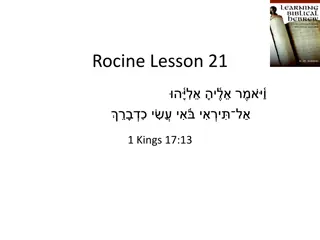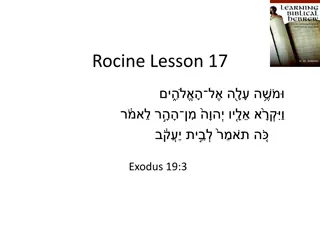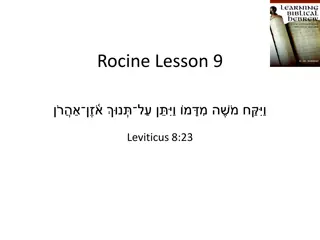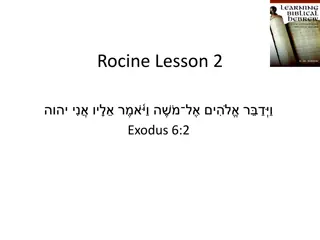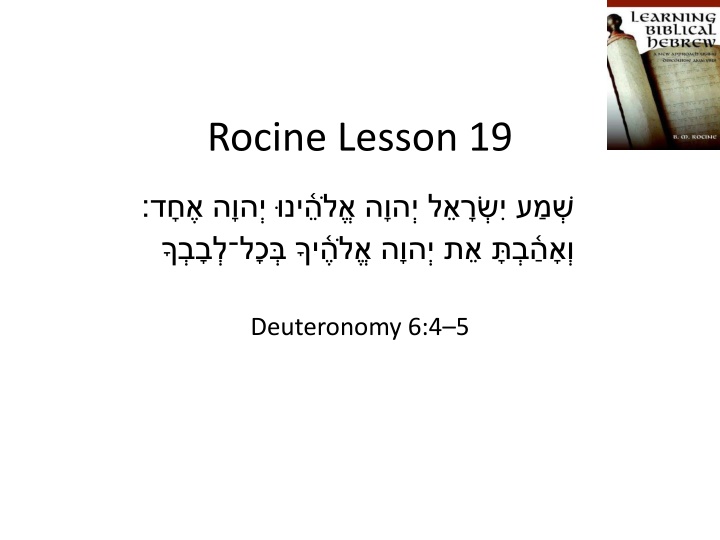
Deuteronomy Lesson: Understanding Command Forms and Hortatory Discourse
Explore Deuteronomy Lesson 19 focusing on identifying and reading Qal masculine singular imperative forms, distinguishing Hortatory Discourse, understanding pronominal suffixes, and learning the mitigative function of weqatal. Engage with translation exercises and review questions to enhance your understanding.
Download Presentation

Please find below an Image/Link to download the presentation.
The content on the website is provided AS IS for your information and personal use only. It may not be sold, licensed, or shared on other websites without obtaining consent from the author. If you encounter any issues during the download, it is possible that the publisher has removed the file from their server.
You are allowed to download the files provided on this website for personal or commercial use, subject to the condition that they are used lawfully. All files are the property of their respective owners.
The content on the website is provided AS IS for your information and personal use only. It may not be sold, licensed, or shared on other websites without obtaining consent from the author.
E N D
Presentation Transcript
Rocine Lesson 19 Deuteronomy 6:4 5
Goals Identify and read the Qal masculine singular imperative. Distinguish Hortatory Discourse from the other direct speech genres. Identify and read the pronominal suffixes. Learn the mitigative function weqatal in Hortatory Discourse.
What we already know Let s try and translate the final clause of our lesson verse. means love is a noun meaning heart You may want to translate the bet on as with rather than in. Translation?
What we already know Let s try and translate the final clause of our lesson verse. means love is a noun meaning heart You may want to translate the bet on as with rather than in. Translation? You shall love YHWH your God with all your heart.
Review 1. Is the first word a yiqtol form?
Review 1. Is the first word a yiqtol form? 2. Does it have the sign of either a Qal or Piel qatal form? No
Review 1. Is the first word a yiqtol form? 2. Does it have the sign of either a Qal or Piel qatal form? 3. What are the signs of the Qal and Piel qatal forms? (6.2b) No No
Review 1. Is the first word a yiqtol form? 2. Does it have the sign of either a Qal or Piel qatal form? 3. What are the signs of the Qal and Piel qatal forms? (6.2b) 4. What is the sign of the Qal participle? (12.2a) No No Qal: 1st root vowel is qamets Piel: 1st root vowel is hireq and doubling of second root
Review 1. Is the first word a yiqtol form? 2. Does it have the sign of either a Qal or Piel qatal form? 3. What are the signs of the Qal and Piel qatal forms? (6.2b) 4. What is the sign of the Qal participle? (12.2a) 5. What letter would very likely be prefixed to our word if it were an infinitive? (16.4a) No No Qal: 1st root vowel is qamets Holem after first root letter Piel: 1st root vowel is hireq and doubling of second root
Review 1. Is the first word a yiqtol form? 2. Does it have the sign of either a Qal or Piel qatal form? 3. What are the signs of the Qal and Piel qatal forms? (6.2b) 4. What is the sign of the Qal participle? (12.2a) 5. What letter would very likely be prefixed to our word if it were an infinitive? (16.4a) 6. What is ? No No Qal: 1st root vowel is qamets Holem after first root letter Piel: 1st root vowel is hireq and doubling of second root lamed
The imperative 1. Is the first word a yiqtol form? 2. Does it have the sign of either a Qal or Piel qatal form? 3. What are the signs of the Qal and Piel qatal forms? (6.2b) 4. What is the sign of the Qal participle? (12.2a) 5. What letter would very likely be prefixed to our word if it were an infinitive? (16.4a) 6. What is ? No No Qal: 1st root vowel is qamets Holem after first root letter Piel: 1st root vowel is hireq and doubling of second root lamed An imperative
The imperative RULE: The sign of the Qal masculine singular imperative is a shewa under the first root letter: Translate this direct order with the English imperative. Listen! or Hear!
The imperative The Qal imperative is often the 2nd person yiqtol forms minus the prefixed pronoun, in somewhat the same way that English imperatives leave the subject unwritten or unsaid. English Imperative Biblical Hebrew Imperative ) ( (You) Listen to the voice of the people! unwritten subject unwritten subject
The imperative It s the same for I-Nun and I-Yod roots. The prefix of the 2nd person Yiqtol is removed to form the imperative. Yiqtol 2ms Imperative ms I-Nun (Rocine 9) I-Yod (Rocine 3)
The imperative It s the same for I-Nun and I-Yod roots. The prefix of the 2nd person Yiqtol is removed to form the imperative. Yiqtol 2ms Imperative ms I-Nun (Rocine 9) I-Yod (Rocine 3) also (Rocine 9) (Rocine 3)
Genres (Review) MODULE ONE: MODULE TWO: outside the quotation marks inside the quotation marks or Direct Speech Historical Narrative Predictive Narrative Instructional Discourse Hortatory Discourse Historical Narrative +projection or forward-looking genres Genre Task Historical Narrative Tell a story about the past. Predictive Narrative Tell a story set in the future. Instructional Discourse Tell how to do something. Hortatory Discourse
Genres (Review) MODULE ONE: MODULE TWO: outside the quotation marks inside the quotation marks or Direct Speech Historical Narrative Predictive Narrative Instructional Discourse Hortatory Discourse Historical Narrative +projection or forward-looking genres Genre Task Historical Narrative Tell a story about the past. Predictive Narrative Tell a story set in the future. Instructional Discourse Tell how to do something. Hortatory Discourse Influence the behavior of someone.
Hortatory Discourse Our lesson verse serves as our introduction to the Direct Speech genre Hortatory Discourse.
Hortatory Discourse Our lesson verse serves as our introduction to the Direct Speech genre Hortatory Discourse. RULE: Hortatory Discourse is the +projection genre in which the speaker/writer is persuading his audience, or trying to alter its behavior. One of its mainline verb forms is the imperative. Like Predictive Narrative and Instructional Discourse, Hortatory Discourse is found only in direct speech.
Vocative Since the subject of an imperative is unwritten, cannot be the subject of the sentence even though it does name the one being spoken to. Rather it names the addressee. It s called a vocative.
Vocative Since the subject of an imperative is unwritten, cannot be the subject of the sentence even though it does name the one being spoken to. Rather it names the addressee. It s called a vocative. The only way to distinguish between a vocative and the regular subject of the sentence is by context, and it is not always a clear distinction.
Pronominal suffixes in two verbless clauses consists of a construct form and a pronominal suffix. Pronominal suffixes can indicate possession or an object. Possession on nouns, preposition An object on DDO, prepositions, verbs
Pronominal Suffixes on Singular Plural 3ms 3mp 3fs 3fp 2ms 2mp 2fs 2fp 1cs 1cp Animated Hebrew lecture 13
Find the differences in the endings. Basic Paradigm DDO + suffix Noun + suffix Basic Paradigm DDO + suffix Noun + suffix Possessive Objective Possessive Possessive Objective Possessive 468x ) ( 3ms 3mp 5x ) ( 4x ) ( 3fs 3fp 13x ) ( 1x ) ( 2ms 2mp 300x ) ( (Not attested in HB) 2fs 2fp 1cs 1cp 33x ( ) Note error in Rocine s table for DDO 2mp and 2fp.
Find the differences in the endings. Basic Paradigm DDO + suffix Noun + suffix Basic Paradigm DDO + suffix Noun + suffix Holem Holem Possessive Objective Possessive Possessive Objective Possessive 468x ) ( 3ms 3mp 5x ) ( 4x ) ( 3fs 3fp 13x ) ( 1x ) ( 2ms 2mp 300x ) ( (Not attested in HB) 2fs 2fp 1cs 1cp 33x ( ) Note error in Rocine s table for DDO 2mp and 2fp.
Find the differences in the endings. Basic Paradigm DDO + suffix Noun + suffix Basic Paradigm DDO + suffix Noun + suffix Holem Note changes. Holem Possessive Objective Possessive Possessive Objective Possessive 468x ) ( 3ms 3mp 5x ) ( 4x ) ( 3fs 3fp 13x ) ( 1x ) ( 2ms 2mp 300x ) ( (Not attested in HB) 2fs 2fp 1cs 1cp 33x ( ) Note error in Rocine s table for DDO 2mp and 2fp.
Find the differences in the endings. Basic Paradigm DDO + suffix Noun + suffix Basic Paradigm DDO + suffix Noun + suffix Holem Note changes. Holem Possessive Objective Possessive Possessive Objective Possessive 468x ) ( 3ms 3mp 5x ) ( 4x ) ( 3fs 3fp 13x ) ( 1x ) ( 2ms 2mp 300x ) ( (Not attested in HB) 2fs 2fp 1cs 1cp 33x ( ) Note error in Rocine s table for DDO 2mp and 2fp. Qamets because noun is grammatically plural.
Pronominal suffixes in two verbless clauses Homework: The four words in blue above can be translated as two verbless clauses or one verbless clause (other options exist as well). Read Rocine 19.4 and write down the translations for the two verbless clause option and the one verbless clause option.
Excursus on the Shema Waltke/O Connor (1990) 8.4.2g The problems posed by the Shema (Deut 6:4) are numerous.21 After the initial imperative and vocative, 'Hear, O Israel,' there follow four words. However they are construed, it is agreed that no closely comparable passage occurs. The simplest solution is to recognize two juxtaposed verbless clauses: (a) "YHWH is our God' (identifying clause, S-Pred); (b) 'YHWH is one' (classifying clause, S-Pred, with a numeral; cf. # 23). Few scholars favor such a parsing. Andersen takes ... as a discontinuous predicate, with the other two words as a discontinuous subject, 'Our one God is YHWH,YHWH.'22 Other proposed parsings take the first two words as subject (viz., 'YHWH our God is one YHWH')23 or the first three words (viz., 'YHWH, our God, YHWH is one') or even the first word alone. It is hard to say if can serve as an adjective modifying . It is even less clear what the predicate would mean, though some scholars take it adverbially ('YHWH is our God, YHWH alone'). As Gerald Janzen observes, "the Shema does not conform exactly to any standard nominal sentence pattern," and further discussion falls outside the sphere of grammar.24 21 See the discussion of J. G. Janzen, "On the Most Important Word in the Shema (Deuteronomy VI 4 5)," Vetus Testamentum 37 (1987) 280 300.
Hortatory Discourse As noted above, our lesson verse serves as our introduction to the Direct Speech genre Hortatory Discourse. Hortatory Discourse is the +projection genre in which the speaker/writer is persuading his/her audience, or trying to alter their behavior.
Hortatory Discourse As noted above, our lesson verse serves as our introduction to the Direct Speech genre Hortatory Discourse. Hortatory Discourse is the +projection genre in which the speaker/writer is persuading his/her audience, or trying to alter their behavior. Genre Task Historical Narrative Tell a story about the past. Predictive Narrative Tell a story set in the future. Instructional Discourse Tell how to do something. Hortatory Discourse Influence the behavior of someone.
Hortatory Discourse Can you see how the first clause above is neither Predictive nor Instructional? Genre Task Historical Narrative Tell a story about the past. Predictive Narrative Tell a story set in the future. Instructional Discourse Tell how to do something. Hortatory Discourse Influence the behavior of someone.
Hortatory Discourse What genre is the second clause? Genre Task Historical Narrative Tell a story about the past. Predictive Narrative Tell a story set in the future. Instructional Discourse Tell how to do something. Hortatory Discourse Influence the behavior of someone.
Hortatory Discourse If we translate in a literal, wooden fashion we may think the second clause could be predictive or instructional. Genre Task Historical Narrative Tell a story about the past. Predictive Narrative Tell a story set in the future. Instructional Discourse Tell how to do something. Hortatory Discourse Influence the behavior of someone.
Hortatory Discourse In fact, however, in Biblical Hebrew the second clause above is hortatory, not predictive nor instructional. Genre Task Mainline Verb Form Function Historical Narrative Tell a story about the past. Wayyiqtol (Rocine 1.2c) Historical Narrative Mainline Predictive Narrative Tell a story set in the future. Weqatal (Rocine 13.2e) Predictive Narrative Mainline Instructional Discourse Tell how to do something. Weqatal (Rocine 16.2a,3a) Instructional Discourse Mainline Hortatory Discourse Influence the behavior of someone. Imperative (Rocine 19.2c) Hortatory Discourse Mainline
Hortatory Discourse In fact, however, in Biblical Hebrew the second clause above is hortatory, not predictive nor instructional. This is the case because the weqatal continues the sense of the imperative that precedes it, even if the imperatival sense is mitigated to some extent. Genre Task Mainline Verb Form Function Historical Narrative Tell a story about the past. Wayyiqtol (Rocine 1.2c) Historical Narrative Mainline Predictive Narrative Tell a story set in the future. Weqatal (Rocine 13.2e) Predictive Narrative Mainline Instructional Discourse Tell how to do something. Weqatal (Rocine 16.2a,3a) Instructional Discourse Mainline Hortatory Discourse Influence the behavior of someone. Imperative (Rocine 19.2c) Hortatory Discourse Mainline
Hortatory Discourse In fact, however, in Biblical Hebrew the second clause above is hortatory, not predictive nor instructional. This is the case because the weqatal continues the sense of the imperative that precedes it, even if the imperatival sense is mitigated to some extent. So we can add a new line below. Genre Task Mainline Verb Form Function Historical Narrative Tell a story about the past. Wayyiqtol (Rocine 1.2c) Historical Narrative Mainline Predictive Narrative Tell a story set in the future. Weqatal (Rocine 13.2e) Predictive Narrative Mainline Instructional Discourse Tell how to do something. Weqatal (Rocine 16.2a,3a) Instructional Discourse Mainline Imperative Weqatal (Rocine 19.2c) (Rocine 19.5a) Hortatory Discourse Mainline Hortatory Mitigated Mainline Hortatory Discourse Influence the behavior of someone.
Mitigated Hortatory Discourse RULE: In Hortatory Discourse the weqatal is a continuation form. It generally continues the string of commands which was begun by one or more imperatives. The weqatal gives commands in a softened or mitigated style as compared to the direct order of the imperative. Translate them as you would in Instructional Discourse and Predictive Narrative. Genre Task Mainline Verb Form Function Historical Narrative Tell a story about the past. Wayyiqtol (Rocine 1.2c) Historical Narrative Mainline Predictive Narrative Tell a story set in the future. Weqatal (Rocine 13.2e) Predictive Narrative Mainline Instructional Discourse Tell how to do something. Weqatal (Rocine 16.2a,3a) Instructional Discourse Mainline Imperative Weqatal (Rocine 19.2c) (Rocine 19.5a) Hortatory Discourse Mainline Hortatory Mitigated Mainline Hortatory Discourse Influence the behavior of someone.
A continuum in Direct Speech Genres Predictive Narrative Mitigated Hortatory Discourse Unmitigated Hortatory Discourse Instructional Discourse Genre Task Mainline Verb Form Function Historical Narrative Tell a story about the past. Wayyiqtol (Rocine 1.2c) Historical Narrative Mainline Predictive Narrative Tell a story set in the future. Weqatal (Rocine 13.2e) Predictive Narrative Mainline Instructional Discourse Tell how to do something. Weqatal (Rocine 16.2a,3a) Instructional Discourse Mainline Imperative Weqatal (Rocine 19.2c) (Rocine 19.5a) Hortatory Discourse Mainline Hortatory Mitigated Mainline Hortatory Discourse Influence the behavior of someone.
A continuum in Direct Speech Genres Predictive Narrative Mitigated Hortatory Discourse Unmitigated Hortatory Discourse Instructional Discourse Lots of imperatives No imperatives Increasing concentration of imperatives Genre Task Mainline Verb Form Function Historical Narrative Tell a story about the past. Wayyiqtol (Rocine 1.2c) Historical Narrative Mainline Predictive Narrative Tell a story set in the future. Weqatal (Rocine 13.2e) Predictive Narrative Mainline Instructional Discourse Tell how to do something. Weqatal (Rocine 16.2a,3a) Instructional Discourse Mainline Imperative Weqatal (Rocine 19.2c) (Rocine 19.5a) Hortatory Discourse Mainline Hortatory Mitigated Mainline Hortatory Discourse Influence the behavior of someone.
A continuum in Direct Speech Genres Predictive Narrative Mitigated Hortatory Discourse Unmitigated Hortatory Discourse Instructional Discourse Lots of imperatives No imperatives Increasing concentration of imperatives A word about mitigation: Mitigation of Hortatory Discourse by replacing imperatives with weqatals (or yiqtols) does not necessarily reflect that the speaker is any less serious or earnest in his intentions. Mitigation merely reflects a gentler style. Genre Task Mainline Verb Form Function Historical Narrative Tell a story about the past. Wayyiqtol (Rocine 1.2c) Historical Narrative Mainline Predictive Narrative Tell a story set in the future. Weqatal (Rocine 13.2e) Predictive Narrative Mainline Instructional Discourse Tell how to do something. Weqatal (Rocine 16.2a,3a) Instructional Discourse Mainline Imperative Weqatal (Rocine 19.2c) (Rocine 19.5a) Hortatory Discourse Mainline Hortatory Mitigated Mainline Hortatory Discourse Influence the behavior of someone.
Parsing the Verbs So how would we parse the verbs in the lesson verse? Root Stem Form PGN Function Root meaning
Parsing the Verbs So how would we parse the verbs in the lesson verse? Root Stem Form PGN Function Root meaning Hortatory Discourse Mainline Qal Imperative ms To hear
Parsing the Verbs So how would we parse the verbs in the lesson verse? Root Stem Form PGN Function Root meaning Hortatory Discourse Mainline Qal Imperative ms To hear Hortatory - Mitigated Mainline Qal Weqatal 2ms To love

